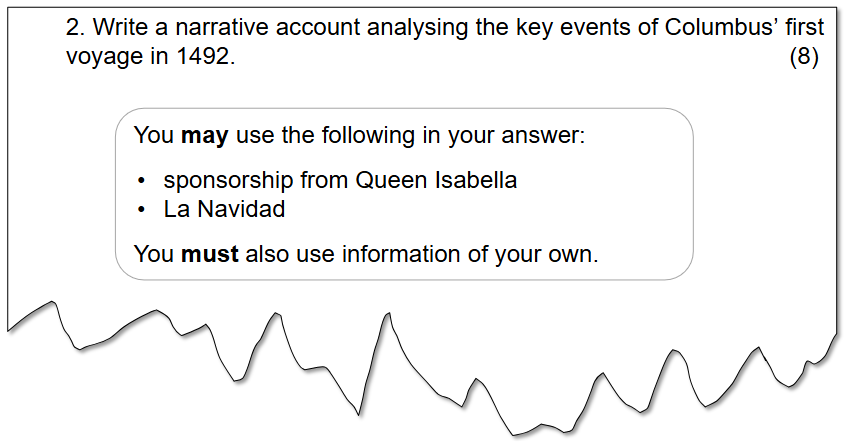The 8 Mark "Write a Narrative Account" Question (Edexcel GCSE History): Revision Note
Exam code: 1HI0
Summary of Question 2
Question 2 requires you to write an analytical narrative
This means explaining a sequence of key events and how they are linked together
You must write about each stage of the narrative in chronological order
Amount of marks | 8 |
|---|---|
The time that you should spend on the question | No more than 15 minutes |
An example of the type of question you may encounter can be seen below:

In previous years, this question has focused on the following topics for Spain & the 'New World':
Year of exam | Question topic |
|---|---|
2018 | The Spanish conquest of Cuba (opens in a new tab) |
2019 | Columbus’ exploration of the Bahamas and the Caribbean (1492) (opens in a new tab) |
2020 | Magellan’s voyage (opens in a new tab) |
2021 | No paper available |
2022 | Montezuma’s actions during the conquest of Mexico by Cortes (1519–20) (opens in a new tab) |
2023 | The expansion of the Spanish Empire, 1513–21 (opens in a new tab) |
2024 | The Spanish conquest of the Incas (1530–37) |
The importance of chronology
Chronology is the ability to place events in time order
In the narrative account, you must write about three events in the correct order
If you write the events out of order, you will only get 2 marks
Do not include events outside the time frame of the question
To help, the exam provides you with two stimulus points
The stimulus points are sometimes given with dates
If not, the stimulus points are arranged in time order
If you do not know the stimulus points, you are allowed to use your own knowledge
If you only use the two stimulus points, you can only achieve a maximum of four marks
Sequencing and linkage in GCSE history
Sequencing
Sequencing in history is the order in which events happened
For the example question, Isabella's sponsorship happened before the creation of La Navidad
A sequence of events could:
Happen over a short or long period of time
Stretch over multiple events
Have negative and positive impacts
When explaining sequencing, you need to be careful not to write a story
Instead, your answer should explain how one event led to another
Linkage
A linkage in history refers to the connections between events or issues
For the example question, Columbus' meeting with the Taino people connects to the creation of La Navidad
Linkage allow historians to:
Compare historical events
Explain the causes and consequences of an event
Explain the wider developments of a period
Use connective phrases like:
"As a result …"
"Consequently …"
"This led to …"
"Because of this …"
Planning your answer will make it easier to make linkages

How to answer a "Write a narrative account" question
Your answer should include:
The organisation of three events in chronological order
Specific and relevant knowledge of each event in the narrative account
An explanation of how each event connects to the next
Before you write the answer, ensure that you have the following:
Good knowledge of the three events that you are using in the narrative account
A clear understanding of how each event links together
This will allow you to achieve the analytical narrative that the examiner is looking for
To create successful linkages for Spain & the 'New World', you should consider if the event:
Improved or damaged relations with the Indigenous peoples
Increased or decreased Spanish power
Increased or decreased the Spanish Empire
Encouraged or deterred Spanish exploration
"Write a narrative account" question structure
Your answers could be written using a CHRONOLINK structure
CHRONO — Put the sequence of events in chronological order
LINK — Connect each section of the narrative to the next event that occurred
To achieve full marks, you should aim to write about three events in the narrative account
These events can be organised into one paragraph per event or one continuous paragraph
The question is out of 8 marks
4 marks for knowledge (K)
4 marks for your analysis of the second-order concepts of causes, consequences and/or changes (SOC)
Worked example of a "Write a narrative account" question
Worked Example
Write a narrative account analysing the key events of Columbus’ first voyage in 1492.
(8)
You may use the following in your answer:
You must also use information of your own. |
Answer:
In early 1492, Queen Isabella and King Ferdinand of Spain agreed to sponsor Columbus’ westward voyage (K). They hoped that he would bring Spain wealth, territory and Christian converts. Their backing was crucial because it gave Columbus three ships and enough resources to attempt a dangerous journey. As a consequence, Isabella’s investment allowed Columbus to sail across the Atlantic. This would have been impossible without royal support (SOC).
Due to this Spanish sponsorship, Columbus reached the Bahamas in October 1492. He mistakenly believed he had landed near Asia and explored nearby islands. On Haiti, Columbus met the Taino people. He described them as generous and easy to convert to Christianity. He also noticed they wore gold jewellery (K). As a result, Columbus claimed the land for Spain and began planning further colonisation (SOC). This marked the start of increasing Spanish influence in the Americas and the beginning of a relationship with Indigenous people that was based on exploitation.
To maintain this influence, Columbus founded La Navidad on the coast of Haiti, using timber from his wrecked ship, the Santa María. He left around 40 men there and returned to Spain to report his discoveries (K). This led to a more permanent Spanish presence in the Caribbean and marked the first European settlement in the Americas (SOC).

Unlock more, it's free!
Did this page help you?